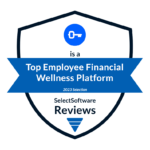Benefits leaders invest so much time, energy, and resources into selecting wellbeing benefits that help employees thrive, personally and professionally. Yet, more than 70% of employees are living paycheck to paycheck, and Americans are struggling with record levels of household debt.
This means that many employees and, by extension, their employers, are facing a crisis of financial illness – not a lack of financial wellness.
Keep reading to learn why innovative employers including Amazon have added financial benefits that support financially vulnerable employees and treat employee financial illness, to create a more comprehensive and impactful wellbeing strategy that improves employee financial health and delivers ROI.
What is financial illness?
Financial illness (sometimes called financial sickness) is the condition where employees are burdened by unmanageable debt, living paycheck to paycheck, and unable to meet basic financial obligations. Their financial needs are:
- Typically urgent, focused on how to afford expenses or obligations that are days, weeks, or a few months away.
- Often surrounded and/or exacerbated by physical or mental health issues, domestic violence, legal woes, and/or caregiving responsibilities.
With just 30% of Americans considered financially healthy, financial illness has become a prevalent workforce problem that affects productivity, turnover, and healthcare costs. A study of one Fortune 50 employer revealed that high financial stress among employees resulted in an additional $22 million in healthcare costs.
Why financial wellness benefits can’t treat financial illness
Despite the best intentions, traditional financial wellness programs often fail to engage or attract the employees who need help the most. A recent survey from Cerulli Associates revealed that while 90% of defined contribution recordkeepers offer financial wellness services, and 71% of plan sponsors have adopted such programs, engagement and usage rates for most resources fall below 20%.
Why? Financial wellness programs often use one-size-fits all financial education and are focused on future goals and retirement. Financially vulnerable employees are not at that stage in their financial health journey. To reach that point, they need a benefit that first addresses the financial needs they face in the here and now – such as how to catch up on past due rent, pay a car note, prioritize bills to align with cash flow, and dig out under from high-interest debt like credit cards and payday loans.
Support for financial illness completes a wellbeing strategy
Money emergencies and debt are the top two reasons employees who have Brightside as a benefit come to us for support, but their challenges are often more complex. Many financially ill employees are struggling with housing and food insecurity, lack transportation to get to and from work, have no savings, and are hindered by subprime credit scores. Without access to unbiased help that alleviates and addresses the root cause of these financial challenges, employees will likely become even more vulnerable.
By adding benefits that offer personalized support and real solutions for urgent needs and crises, money emergencies, and debt while also empowering employees to start to building savings and make the most of the money they earn, benefits leaders can help employees find the stability they need to progress their financial health.
The ROI of treating financial illness
Once Amazon added Brightside Financial Care to complete its financial health strategy, the need for a benefit that treats employee financial illness became apparent. “For every dollar we put into the program, the employee gets about $3 worth of value,” said Justin Roberts, Amazon’s senior manager of financial benefits.
Why not embrace the opportunity to make an even greater impact on your organization by adding benefits that address and offer solutions for the immediate and complex financial needs so many employees face? To learn more about Brightside and how other innovative Fortune 500 employers use it to complete their financial benefits offering, click here.





